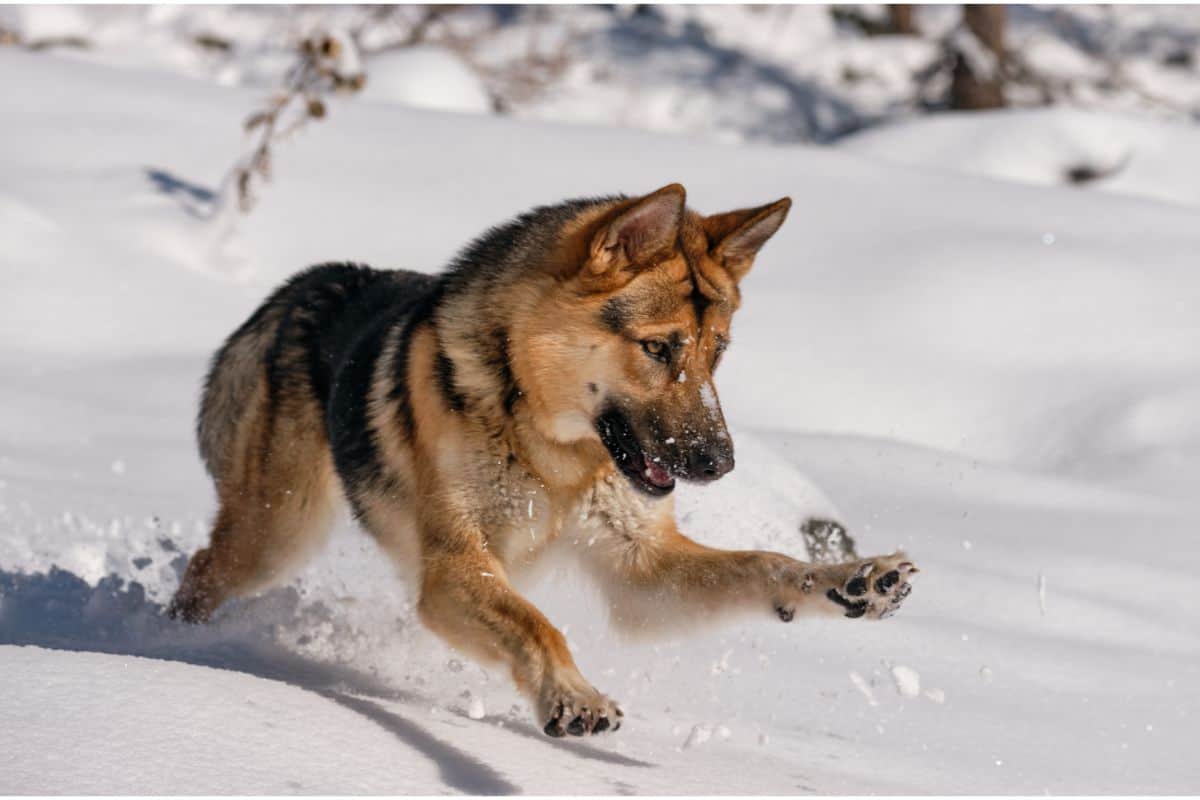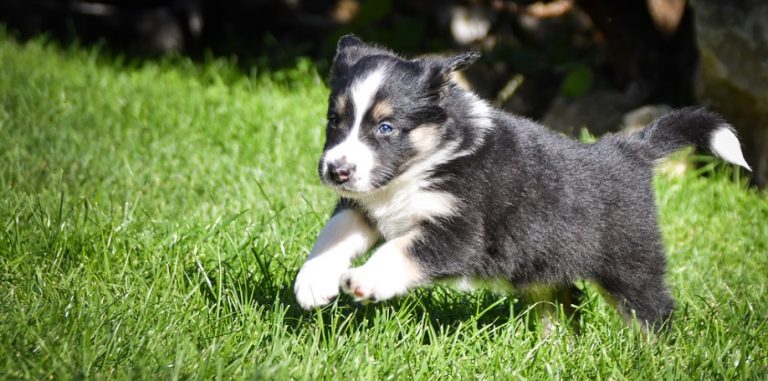When Is It Too Cold For Your German Shepherd?
All dogs have a different level of tolerance for cold weather. So it’s reasonable to have a concern for your German Shepherd if the temperature goes below 0.
We’ll tell you why your dog can handle the cold. However, you can follow our tips to keep them warm in the winter months.
See, the German Shepherd has a double coat, and they can handle temperatures as low as 30° Fahrenheit. Of course, that’s if your dog has short hair.
If you have a long-haired one, it can handle even lower temperatures. But that’s not to say that this is an all-encompassing rule for all dogs. Some factors, such as age, health, fitness, and weight, can affect how a German Shepherd copes with the cold.
Can German Shepherds Handle The Cold?
German Shepherds were not bred to handle the snow. Instead, they were born to work with people and livestock. With a double coat, they have two layers of fur, and you need to monitor them in different weather.
These coats help regulate your German Shepherd’s temperature, regardless of climate.
The outer coat will protect your dog from snow and ice and is essentially a guard coat. Typically, this fur is longer. However, its undercoat is thick and soft, and it will insulate your German Shepherd and protect it from the cold weather.
It will likewise do the same during the summer months.
Typically, German Shepherds love the snow and are happy to run around and play in it. Usually, when they’re cold, they will simply come back inside to warm up again.
The best thing you can do when your German Shepherd heads outside is to keep an eye on them and look for any signs of discomfort.
When Is It Too Cold For Your German Shepherd?
Every dog has their own way of handling cold weather, and each German Shepherd has their own preference. Some owners have pointed out that their dog can easily handle temperatures of 30° Fahrenheit without any issues.
At least, that is the standard for some short-hair German Shepherds.
Some long-haired German Shepherds can handle temperatures as low as 10° Fahrenheit. However, you need to monitor them carefully, as they can only sustain their comfort for a short period.
You want to make sure that your dog can still regulate its temperature.
Ideally, when you take your dog out in below-freezing temperatures, you want to ensure they’re not out for long. If you can, take them out for about 15 or 20 minutes. As you do this, keep an eye on how they handle the weather.
Some factors, such as age, fitness, health, and weight, can impact how your German Shepherd will respond to the cold. So make sure you remember this when you take them outside.
How Can Age Impact Your German Shepherd?
Now, let’s start with the age of your German Shepherd. Puppies have a thin coat, so winter is a struggle for them. Compared to adult dogs, their muscles haven’t developed enough to regulate their body heat either.
If you have a puppy and you’re worried about their reaction to the cold, make sure they have a nutritious diet, and you could even give them a coat when they go outside.
Depending on the age of your adult dog, they might struggle too. Once German Shepherds get too old, their fur starts to thin, and their muscles weaken.
Truthfully, an older dog’s immune system doesn’t work like it used to, so you should always be careful when you need to go outside. Once again, I would recommend a coat to help keep your German Shepherd warm when you have to go outside.
How Can A German Shepherd’s Fitness Impact It?
When I think of a dog’s fitness, I’m referring to how active they are. A German Shepherd with a lot of stamina who runs around won’t struggle with such cold temperatures.
Instead, they’ll be able to remain warm with how active they are.
Because German Shepherds have been bred to be active all day, it’s not unnatural for them to adapt to the cold by running around.
How Can A German Shepherd’s Health Impact It?
Now, a happy and healthy dog can easily handle cold weather. After all, your German Shepherd will be able to keep itself active to stay warm in the cold. But you should keep an eye on your dog when it’s sick.
When your German Shepherd is sick, the extra energy in its body is directed toward healing it. The energy that would keep your dog warm is all used to help its recovery time improve. If your dog is sick, it’s a better idea to keep it warm.
How Can A German Shepherd’s Weight Impact It?
Slim German Shepherds that appear to be losing weight may struggle in the cold. They might not have enough body fat or muscle to retain heat.
If your dog looks like it’s losing weight, you want to keep an eye out. After all, your dog can use body fat to make extra energy and help keep it warm.
Give your dog some meat and salmon if you want to build up their weight. These are calorie-dense foods but should be monitored carefully.
You don’t want your dog getting overweight, either. If you’re going to ensure it stays at a moderate weight, include some plant-based protein like sweet potatoes or pumpkin.
So long as their diet is given more fat and fiber, they’ll also have better digestion.
How Do You Know Your Dog Is Struggling With The Cold?
Like humans, not all German Shepherds react to the cold similarly. Some may enjoy it, while others may hate it. But if you notice your dog is struggling, there are some signs for you to watch out for.
Humans tend to shiver when they get cold; the same can be said for your dog. If it’s shivering, it’s too cold for it. But if you’re outside, you may notice that your dog could benefit from some extra layers.
However, that’s not the only way to tell. While shivering is the obvious sign, there are other ways they can show their discomfort. You need to take your German Shepherd inside if it’s whining, anxious, slower or stops moving altogether.
These are all signs of your dog getting too cold and struggling for it.
You should also check on your German Shepherd’s paws as you walk. They might have cracked feet from the cold. However, they may also have ice accumulating in their toes.
One way to handle this is by cutting their toe hair, but if you can’t, you might need to look for other examples of how you can exercise your dog inside.
But how can you make it easier to look after your dog in the cold? Here are a few ways to help your German Shepherd have an easier time in the cold.
How Do You Keep Your Dog Comfortable In The Cold?
If you’ve noticed your German Shepherd struggling with the cold, there are ways that you can make it easier. There are different items that you can buy that will help your dog handle the cold.

These items help to keep them warm or recover from the effects of the cold. Each of these items can help you out when the weather gets tough. So let’s take a closer look at how these products work.
Dog Jacket
I mentioned how a dog jacket could help your elderly or young pup. Puppies can’t insulate like adult dogs, as the coat either hasn’t grown or has thinned out. So, you can always grab a dog coat to put on them when you need to go for a walk.
These dog coats can be waterproof and can also be found in different shapes and sizes. One of the fun parts about dog jackets is that you can pick and choose your colors, making it easier to find your dog if it’s running around.
Safety LED Collar
A downside of winter is that not only does it get colder, but it gets darker earlier too. So you want to make sure that your German Shepherd is easy to find.
While you could get your pup a hi-vis jacket, an adult dog might benefit from a collar. It’s a great way to keep your dog visible, and you can keep it lit for hours.
They can be charged quickly and are made of a soft material, so they’re comfortable for your dog too.
Dog Boots
Though it may seem challenging, dog boots can help protect your pup’s paws from the snow and the ice. They work brilliantly to protect your dog’s feet, especially if you’re planning on walking them for a long time.
If you want to put some dog boots on your pup, make sure you distract them first. If they’re doing something else when you put them on, they won’t notice there’s something on their feet.
Then feel free to reward your dog, so they’ll know it’s not a punishment.
Paw Balm
Historically, paw balm has been used to help dogs heal after walking in the snow. If you can’t put on dog boots, then paw balm is a way to protect them from any injury.
There is various debris that your pup might step on by accident, such as ice, salt, or snow. So rub some balm onto their paws before you go out to ensure they’re well-protected.
What If You Can’t Take Your Dog Outside?
If you can’t take your dog outside because the weather is too dangerous for you both, then don’t worry. There are ways that you can exercise your dog at home.
If your dog hates the cold, then there are ways that you can use up the energy at home, even if it’s in your yard. Here are some ideas on how to keep your dog engaged easily.
Teach Your Dog A New Trick
If you need to keep your German Shepherd engaged mentally, don’t be afraid to teach them a new trick.
You might feel like it’s a challenge, but even if it’s something simple like “roll over,” you might find that it will keep them entertained. You can always teach them a new one each week, so they’re still keeping mentally engaged.
Play Brain Games
You can get a brain game from any pet store near you. Usually, these consist of hiding a treat inside a toy and leaving your German Shepherd to find it.
You’d be surprised at how engaged your dog will be trying to find this treat, and it’s a great way to keep them entertained while you’re busy.
Make An Agility Course
Depending on the size of your house and the size of your German Shepherd, you could make an agility course. You can use any kind of furniture, so long as they can jump around on it.
If you still want to take your dog outside for small amounts of time, you can still do so with these agility courses. You can easily monitor your dog here and bring them inside quicker if they struggle outside.
Doggy Push-Ups
If you want to physically and mentally engage your German Shepherd, consider doing doggy push-ups. To explain a doggy push-up, it’s where you lead your dog from a sitting position to a down position.
You then do this on repeat. You can lure your pup with treats, or if they already know how to do it, you can see how long it takes them to get bored.
Doggy push-ups are an interesting way to spend your time and a more low-effort way than the agility course.
Run Up And Down The Stairs
Running up and down the stairs is a way for both you and your dog to burn off some steam. However, you need to be careful when you do this.
You don’t want you or your German Shepherd to get hurt. Once again, this depends on the size of your house. It might not be ideal if you have a small place with only one floor, but if you have a big enough house, this could be a lot of fun.
Play Hide-And-Seek
Hide-and-seek is a fun game for both you and your dog. While having your dog hide from you won’t necessarily work, you could find a place to hide and let your dog come find you.
You can get creative about where you hide, and it’ll be a fun way for your German Shepherd to use its nose to deduce where you’re hiding.
Play With Them Outside
If you’re worried about taking your pup out for too long an amount of time, then don’t worry. You can still take some toys and play with your German Shepherd outside.
You can easily restrict the amount of time they’re playing out here, so you don’t have to worry about them getting hurt. Playing with them outside is a great plan if they’re still very young or not as young as they used to be.
Rotate The Toys Around
If your German Shepherd gets bored of its toys, you can continuously rotate them around. Instead of leaving all of them out for your dog to play with, change them around every now and then.
Doing this will keep them guessing which toy they get to play with at a time.
Chase Bubbles
While this isn’t the most popular of choices for all dogs, you might find your German Shepherd will love chasing bubbles. Grab a bubble blower and let the bubbles loose in your house or yard.
Your dog may either absolutely love it or be unimpressed. You can only try and find out how your pup will react.
Final Thoughts
Every German Shepherd reacts to the cold differently, but the best thing you can do for them is to keep an eye on their body language. If your dog is shivering or slowing down, take a step away from the cold and bring them inside.
Just make sure that you keep exercising your German Shepherd. After all, you want to ensure they stay mentally and physically active.
Frequently Asked Questions
How Cold Is Too Cold For A Dog?
Truthfully it depends on the dog. While we have noticed that dogs can handle being out at 30° Fahrenheit, some dogs may struggle at 40°. It depends a lot on the type of dog you have and how much they hate the cold.
One piece of advice is that if you feel like it’s too cold for you, it’s probably too cold for your dog.
How Can I Walk My Dog In The Snow?
Unless you have a really good reason, you should still be walking your dog. There are numerous ways that you can walk your dog in the snow. You can protect their paws with dog booties or balm and trim their nails and hair on their feet so it’s short.
If you can, try to prevent your German Shepherd from pulling, and stick to snow-covered areas, so you don’t accidentally step in salt.
Try to avoid frozen bodies of water to prevent your dog from falling in, and keep an eye on how they respond to the cold.
Do German Shepherds Need A Coat In Winter?
You’ll only need a coat for your German Shepherd if it’s very young or very old. If your German Shepherd isn’t either of these, you may find that it will just become uncomfortable, as their coats are thick enough to withstand the cold.
However, that doesn’t mean they can stay outside for a long time.
How Can You Tell Your German Shepherd Is Cold At Night?
Your German Shepherd will be shaking and shivering like when you are outside together. You’ll find their posture is hunched, and they’ll have their tail tucked in.
If they’re seeking more places for shelter, they’re probably trying to get warmer. Outside, they’re likely trying to find shelter and will probably want to turn around, and if they do, you should take them inside.
If your dog’s cold inside, get them a few more blankets so they’re comfortable.






